Flounder Fishing – An Expert’s Guide
As I slowly drifted a live shrimp over shallow mud and oyster bottom near Dauphin Island, Alabama, my cork just stopped, as if it was hung on the bottom. I tightened my line to dislodge the snag only to feel a tap on the other end. As I set the hook, the feeling was like nothing I had experienced before. The dull fight stayed deep, and I wasn’t sure what I had. Nearing the boat, the fish remained out of sight, until it was almost completely out of the water. A quick scoop with the net and I had my first ever flounder, and while I wasn’t even flounder fishing per se, I was hooked on learning more about this awesome eating and mysterious fish.
Landing this 3lb fish was a real bit of excitement for a young boy, as were most fish in those days. While the excitement of catching some species has faded slightly over the years, I still get just as excited when I see one of these camouflage warriors at the end of my line. And judging from my discussions with other anglers, I’m not the only one who has never lost his enthusiasm for these fish. In this comprehensive guide, we will glean information from two expert flounder fishermen and delve into the art and the science of flounder fishing. From the identification of common flounder species to the habitat, gear, and techniques you will need to catch them, whether you’re just getting into flounder fishing or you’ve been doing it for years, this article will equip you with what you need to know to put more flounder in the boat.
Flounder Fish Identification
Throughout the flounder’s range, there are many species that inhabit the same areas. It is important that you be able to identify the various flounder species as seasons and bag limits can vary by State and region. Below you will find some helpful tips on identifying the some various species of flounder you may come into contact with.
Gulf Flounder Vs Southern Flounder
Gulf Flounder and Southern Flounder are two distinct species of flounder that belong to the same genus but are different species within the flounder family. In terms of body shape, coloration and camouflage, I have yet to see a better guide for identifying Gulf Flounder vs Southern Flounder than that which was put out by the North Carolina Department of Marine Fisheries. Refer to it for all specifics available for identification such as gill raker count. The easiest giveaway is that Gulf Flounder have three prominent ocellated spots which form a triangle on their body whereas Southern Flounder do not have these “eye spots” and instead have many “non-ocellated” spots on their body in a mottled pattern.
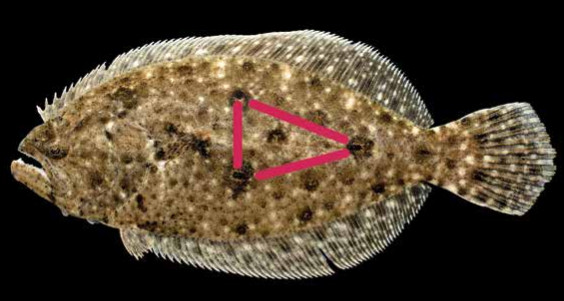
Gulf Flounder (Photo courtesy of North Carolina Division of Marine Fisheries)
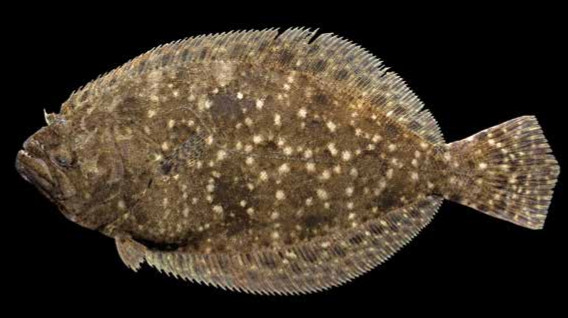
Southern Flounder (Photo courtesy of North Carolina Division of Marine Fisheries)
Winter Flounder Vs Summer Flounder
Winter Flounder and Summer Flounder, are two distinct species that are often compared due to their similar appearance and habitat. Winter Flounder are typically found in the western Atlantic Ocean, ranging from Labrador in Canada to Georgia in the United States. They inhabit cold-temperate waters, including bays, estuaries, and nearshore areas. Summer flounder, also known as fluke, are primarily found along the eastern coast of North America, ranging from Nova Scotia in Canada to Florida in the United States. They inhabit warmer coastal waters, estuaries, and bays. Winter Flounder have a dark brown or olive-brown coloration with irregular spots and blotches. Summer Flounder, on the other hand, have a mottled coloration with light and dark patches.
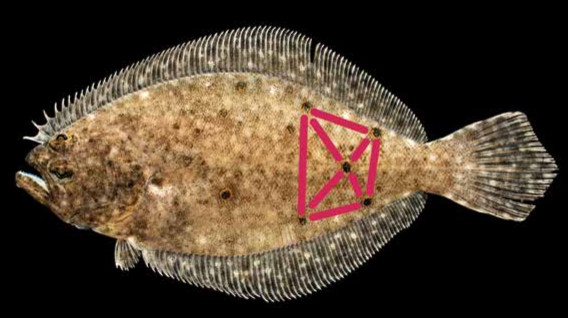
Summer Flounder (Photo courtesy of North Carolina Division of Marine Fisheries)

Winter Flounder
How Big Do Flounder Get?
Winter Flounder typically grow to lengths of about 12 to 22 inches and weigh between 1 to 4 pounds. Some individuals can exceed these size ranges, but they are less common. The world record Winter Flounder is 7lb 0 oz caught by Dr. Einar Grell in Fire Island, New York. Summer Flounder, on the other hand, can grow larger compared to Winter Flounder. They commonly reach lengths of 12 to 25 inches and commonly weigh anywhere from 1 to 8 pounds. The world record Summer Flounder is 22 lb 7 oz caught by Capt. Charles Nappi in Montauk, New york.
Gulf Flounder generally have a similar size range to Winter Flounder. They commonly measure between 12 to 25 inches in length and can weigh from 1 to 7 pounds. The world record Gulf Flounder is 7 lb 2 oz caught by Charlie Aman in Bogue Sound North Carolina. Southern Flounder are also similar in size to their Summer Flounder relatives. They typically grow to lengths of 12 to 25 inches and commonly weigh between 1 to 8 pounds. The world record Southern Flounder is 20lb 9 oz caught by Larenza Mungin in Nassau Sound, Florida.
Flounder Habitat
Flounder are primarily found in coastal and nearshore habitats around the world. They inhabit a variety of environments, including estuaries, bays, lagoons, sandy or muddy bottoms, and seagrass beds. Flounder can be found in shallow as well as deeper waters and will change their habitat based on their spawning habits and water temperatures. The depth range for flounder can vary depending on the species and local conditions as flounder species have different tolerances for temperature and salinity levels. They can be found in both brackish and saltwater environments. Some species, like the winter flounder, are adapted to colder waters, while others, like the Gulf flounder, inhabit warmer waters.
Southern Flounder Habitat
Southern flounder exhibit a strong affinity for estuaries, including tidal creeks, sounds, and brackish water environments. They are particularly adapted to thrive in these transitional areas where freshwater from rivers and saltwater from the ocean mix. The availability of both food sources and suitable nursery grounds makes estuaries vital for the survival and growth of southern flounder. Southern flounder inhabit shallow areas with sandy or muddy bottoms, as well as seagrass beds and oyster reefs, which provide them with camouflage, protection, and potential food sources.
How To Catch Flounder with Capt. Richard Rutland and Dylan Kiene
We recently caught up with two flounder experts on the Alabama Saltwater Fishing Report. Captain Richard Rutland of Cold Blooded Fishing has been guiding for flounder along coastal Alabama for over a decade. Dylan Kiene is a flounder researcher and Ph.D. student at the Marine Science Department at the University of South Alabama. We asked them to give us their expert opinions on a variety of topics pertaining to flounder fishing.
What Do Flounder Eat?
Dylan Kiene has analyzed over 1,400 flounder in his research and here is what he had to say about what flounder eat based on actual gut content analysis. “Early in their life, they’re going to key in on mainly small fishes and shrimp, but they grow pretty quickly. Females reach about 12 inches in the first 10 or 11 months and once they start to get to that larger size, they start switching over to more of a fin fish based diet. And so they’ll still go after shrimp and stuff like that when it gets near the bottom, but they’re really going to key in on those finfish that have that higher fat content and make it worthwhile for them to give up their ambush points to get that bait.

To go after larger flounder like this 5lb doormat, you will have to adjust the bait you choose. Bigger croakers and bigger mullet are the way to go.
As they get much bigger, once they get over that 20-inch mark into that three, four or five-pound range they’ll start feeding on bigger croakers and big finger mullet. Finger mullet are the most popular things in their stomachs. And another cool thing is in the springtime, we see a lot of High Fin Goby in their stomachs, especially from fish that come from the tidal river systems. These are very long slender fish, anywhere from like six to ten inches long. So that’s one of the reasons that I think they like any kind of jerk bait such as the Lil Slick in the springtime.”
Best Flounder Lures
There are a variety of lures that will deceive a flounder. In terms of color, Captain Richard really likes the bright colors pearl white, chartreuse, pink, and electric chicken. “Since with those little tiny eyes who knows how much they can actually see and they are just sitting down there waiting for something to swim by. I think that the more you can do to make your bait stand out better the more fish you will catch. I’ve had good luck flounder fishing with Fishbites Fight Club Curly Tails. While I think color and action are key factors in the best bait for flounder, scent is important and Fishbites offers some options and it is best for you to experiment and see which works best for your situation. Even the scent on plastics can make a difference. I’ve used jigs with a strip of mullet, croaker, shrimp, or other fish just to embellish the bait,” Rutland said.
Best Bait For Flounder
Flounder are ambush predators that will take a variety of bait if presented correctly. Captain Richard Rutland had this to add about what he thinks are the best baits for flounder. “While you can catch flounder on a number of different natural baits, the best is finger mullet. Based on my tagging experience, probably 70% of all of the flounder that we caught and tagged were caught on finger mullet. We spent between 1-2 hours a day searching for and catching finger mullet for our tagging studies. My normal go-to net is an eight-footer with about 1.2-1.3 pounds of lead per foot and I prefer a 3/8-inch mesh but you could go down to a ¼-inch mesh if you are looking for smaller baitfish. I use the 3/8 inch because I believe that 4-6-inch finger mullet are the best bait for flounder and, just like speckled trout, there isn’t a bait too big to present to these fish. When we catch fish for tagging, unfortunately, some are gut hooked so we do a gut content analysis and I’ve found a 4-5-inch baitfish in the stomach of a 14-15-inch flounder. It was kind of unreal.”
Best Flounder Rig
There are a variety of flounder rigs that anglers employ to catch flounder, but there are two that stand out for Captain Richard. “When it comes to the best live bait flounder rig, far and away, I use the standard Carolina rig with a couple of small wrinkles. I use a 10-14-inch 20-pound fluorocarbon leader, with a half-ounce or less egg weight.
Deciding on whether to fish live bait or artificial lures kind of depends on what type of structure you are fishing, whether it is rocks, oyster shells, or maybe a steep sandy ledge. It also is a bit of a “try it and see” challenge to see which type of presentation is the most effective. When I’m fishing rocks, I definitely prefer to fish a jig over a Carolina rig and one of the main reasons is I won’t get hung up as often. Now keep in mind that if you don’t get hung up when you are fishing rocks and tying on new hooks, sinkers, and swivels, you aren’t fishing where the fish are. Having said that I think that you can get “unhung” more often with a jig than you can with a Carolina rig.”
Best Hook For Flounder
Your hook choice is important when flounder fishing, not only the style but also the size. For a Carolina rig, Capt. Richard had this to say, “I like size #1 or #2 Owner SSW live bait hook, depending on the size of the finger mullet. Smaller mullet that are 3 to 4 inches go with a #1 and larger go with a #2 hook. For artificial baits, I exclusively fish a Hogie 3/8 Ounce Spring Head with 4/0 Gamakatsu Hooks but you can step it down a little bit if you want to, but I like the 3/8 size because I feel the bottom well with that weight in most fishing situations.” I’ve found the Hogie Jig heads to be really hard to find, but a good substitute is the Mustad Impact Spring Lock Jig Head.
Flounder Jigging Techniques
When Captain Richard was asked about flounder jigging, the key is finding the right areas and working them over thoroughly. “I also prefer a jig when fishing areas that are really steep. Flounder love really steep banks where it goes from about three feet of water down to around 20 feet quickly. It’s kind of like looking up at a steep bank and a jig allows you to fish it from the top down or the bottom up and still have control and feel the jig on the bottom.
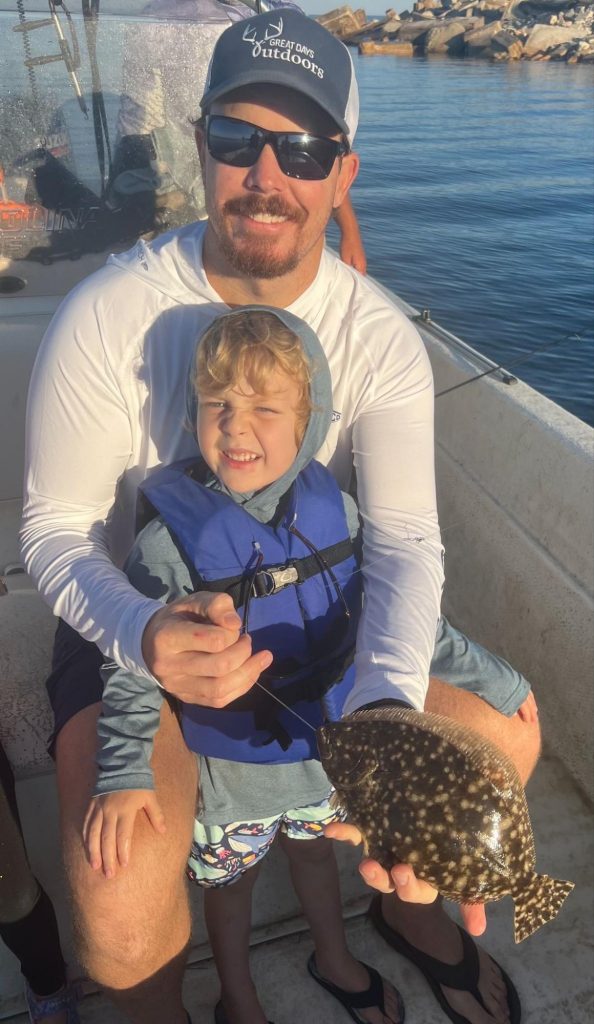
Going after flounder is a unique fishing experience that ends with a delicious reward.
For flounder, I always like to get up on the shallow side and cast out to the deep side and work your bait up, and have found that to be much more effective than going from shallow to deep. I also keep my “hops” very short, probably coming off the bottom only four or five inches. I call that action “ticking” and I just raise my rod tip enough to move the jig a foot or so and allow it to come up and then fall down and make a slight disturbance in the mud or sand.”
How To Catch Flounder From Shore
Dylan Kiene relies on his knowledge of how to catch flounder from shore for a lot of his flounder sampling. He had this to say about targeting flatties from land. “The tide is the king and the wind is the queen and so I use those two factors to play to my advantage 99% of the time. A lot of the time your shore spots are going to be higher water dependent. I like to fish the top half of the incoming and the top half of the outgoing. That’s not always true for every single spot but a lot of times as the water gets higher that’s when those structures up close to the bank will flood and that’s where the Flounder want to be. They’ll sit near that bank or near any of that structure kind of facing it and any prey that gets in between them and the structure, they can run them up against that structure to make it easier to ambush it.
The wind can also be very important, especially on days when you have a neap tide, lower tidal movement, or no tidal movement at all. If it’s windy or the winds coming out of a certain direction, you can use that to fish eddies or any kind of wind-driven current that’s created. One of the things that I like too is little creek mouths. The best time is right at the start of the outgoing tide, if there are any creeks that you can access to get flooded and you have access to the mouths, those flounder come stack up in the mouths right at this flip of the tide, and start catching the bait that is getting pulled out of there.”
Best Time Of Day To Catch Flounder
I wanted to know if the time of day had an influence on flounder catches. So why not rely on science to give us the answer? I asked Dylan, “Has your research helped you to reach any conclusions on if there is a “best” time of day to catch flounder?” He had this to say, “So I think that’s one of the beautiful things about flounder fishing, is the time of day does not seem to be that important for them. In general, we catch them all day, every day. High sun, it doesn’t matter and that’s the beautiful thing. It’s really easy to work flounder into a trip you know if you want to target fish that are light sensitive, like speckled trout, in the morning for a few hours and then you can flounder fish the rest of the day and expect to still have just as good of a bite as you would at any time of the day. The most important thing for them is those conditions I mentioned before.”
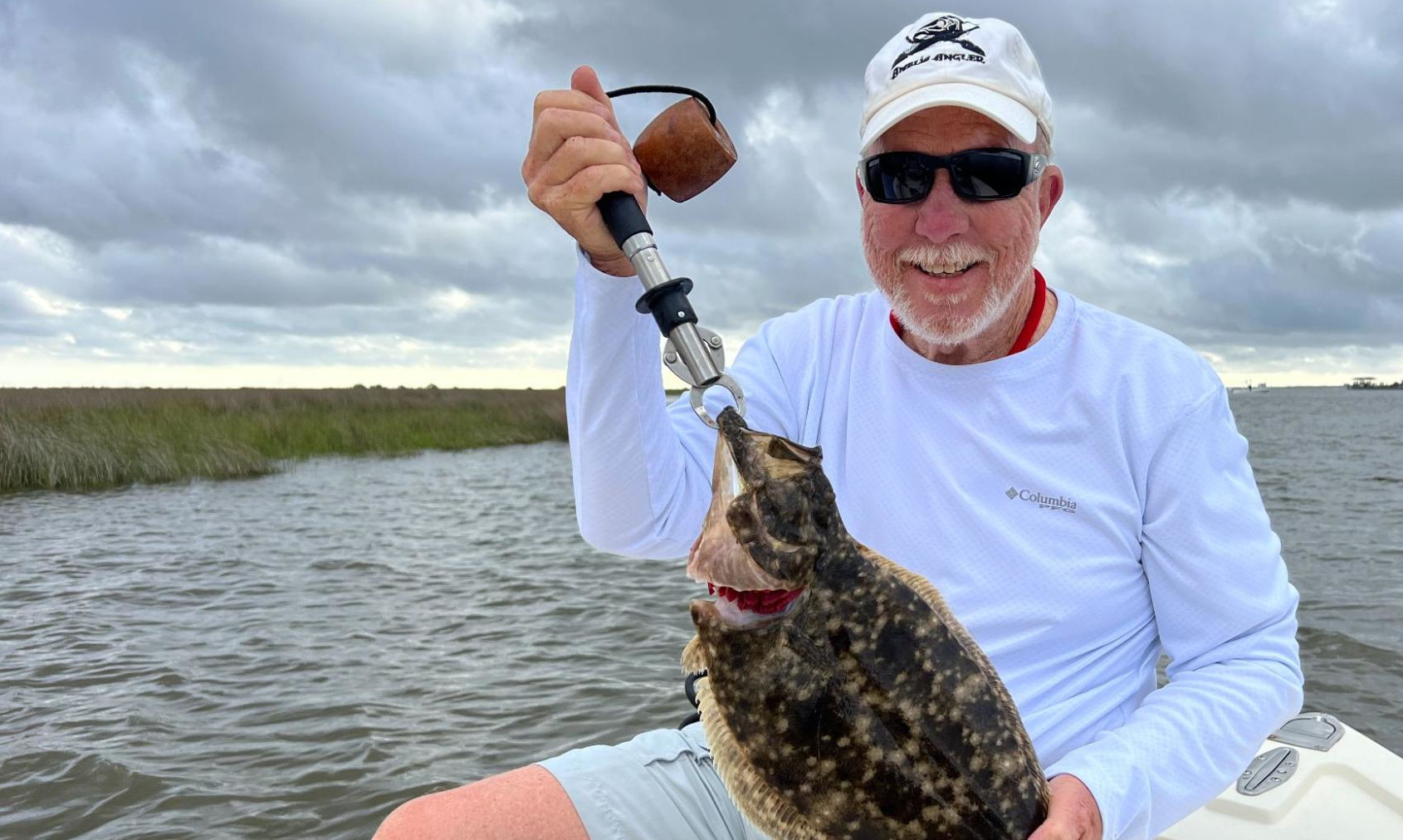
Flounder Fishing tidal creeks can be deadly effective is you choose the right time to fish them.
How To Fillet A Flounder
My personal favorite way to prepare flounder is to scale, score, and fry whole. But when you catch a flounder that is too large for a pan, filleting is in order. Filleting a flounder is not hard, but it is different than most other types of fillet jobs you might be used to. My good friend Hank Shaw has detailed this process over on his website, Hunter Angler Gardener Cook. Check out this link to see the full detailed process of how to fillet a flounder.
Fried Flounder Recipes
Flounder can be prepared in many ways. The tender, mild, white flesh is good in all types of preparations but my personal favorite flounder recipes are fried. Call me boring, I’ll call it delicious. If you are looking for an excellent fried flounder recipe using fillets, check out Hank’s Recipe. As mentioned previously, if you have a small flounder, under about 16” in total length, I highly recommend you cook it whole, minus the scales and head. Paula Deen has an excellent recipe that I have used before. To take her recipe to another level, head to your local Mexican Grocery and pick up some lard and fry your fish in that instead of vegetable oil. You won’t be disappointed.
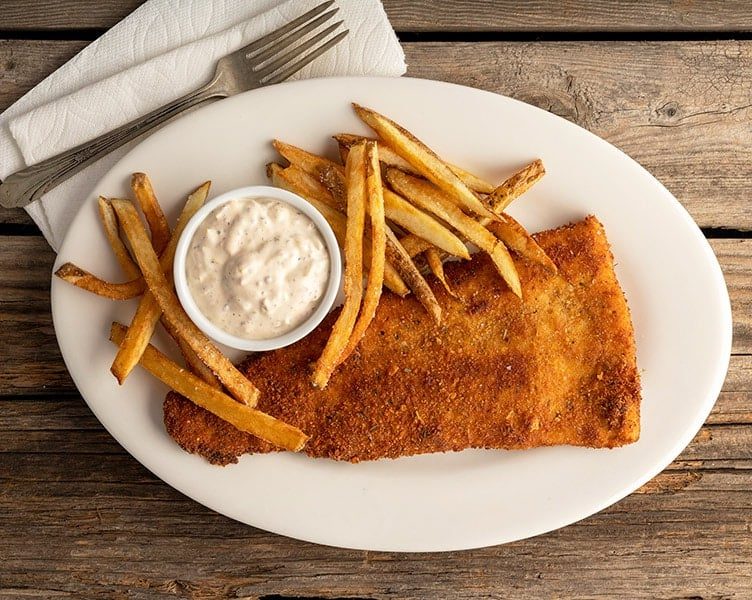
Fried flounder with homemade tartar sauce. (Photo courtesy of Hank Shaw)
Flounder Fishing Final Feelings
I doubt the excitement of a flatfish will ever fade for me. I don’t know if it’s the novelty of catching a flounder when I didn’t expect it, the promise of a delicious meal, or just the uniqueness of the flatfish as a family, but flounder fishing holds a special place in my memories. If you want to create more memories of your own, slow down and take heed to the tips from these experts and you’ll be on the meat in no time.
Full Disclosure: This post may include affiliate links. There’s no extra charge to our readers for using these.
